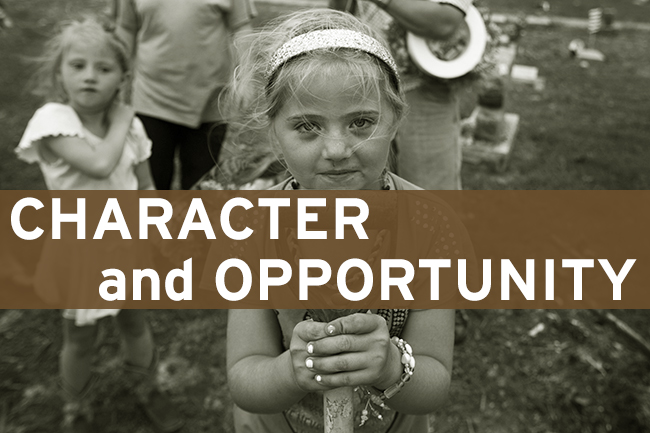In this essay from the Center on Children and Families’ Essay Series on Character and Opportunity, Joseph Fishkin writes that there is no such thing as inner ability or character that sits separate and apart from experience, and that every experience is filtered through the particular character of the person who experiences it.
Much of the modern debate about equal opportunity has been taken up with the following question: which elements of a person’s successes and failures are the result of her inner abilities or inner character, and which are the result, instead, of experience – in particular, the advantages and disadvantages the person soaked up from her family, school, and society?
In general, conservatives insist that inner abilities and character are most of the story. Liberals insist that it’s mostly social advantages and disadvantages. But both sides agree that this is the right question.
And both sides are wrong.
There is no such thing as inner ability or character that sits separate and apart from experience. Every experience we have, every advantage or disadvantage, is filtered through the particular character and other traits of the person who experiences it. And all of those traits are themselves a product of what has come before. In other words: We are all sedimentary creatures. Our abilities and disabilities, our preferences and values, and our character traits all arise through layer upon layer of dynamic interaction between self and environment that build us, gradually over time, into the people we are.1
All this is unsettling for a certain type of egalitarian. One of the more thoroughgoing strands of egalitarian thought in contemporary political theory is called luck egalitarianism. The idea is that society ought to do its best to eliminate the effects of brute luck on a person’s prospects, so that where she ends up in life depends on her own decisions – and her own character – rather than on the vicissitudes of chance. There is much that is appealing about this ideal. But its core turns out to be hollow. When we strip away the effects of luck, such as the luck of where a person grew up, the luck of where and to whom she was born, and so on, we strip away her character, too.
The current conversation about character is in many respects a welcome departure. The fundamental premise of the Character & Opportunity Project at Brookings is almost certainly correct, and important: character is an important factor that influences how well people do at various important junctures in life when they face particular challenges. It seems likely that character traits therefore affect many people’s socioeconomic trajectories. It will be useful to develop a clearer picture of which character traits matter when – and how those character traits are built.
But as this research agenda proceeds, we ought to keep in mind, as a cautionary tale, Americans’ long and surprisingly unilluminating debate about the origins of ability. From the early promise of IQ testing – the shattered hope that scientists might isolate some inner variable, invariant with age or schooling or life experience – through the meltdown of the Bell Curve, Americans have found highly seductive the idea that if something about a person’s mind shows up in a scientific test, it is probably inborn. Our embrace of this odd premise seems firmest when images are involved. If people differ in a manner that is visible on a bright and colorful MRI, we tend to conclude that the difference is deep, probably innate. This is just laziness on our part. We would never think this way of any organ besides the brain. When you measure the muscles of professional athlete, you are obviously observing the result of a lifetime of training and experience. The brain is no different.
That is not to say that every brain will react the same way to every experience. We are all different. But our differences are not in any simple way innate. There is no way, through any test or scan or other device, to isolate any hidden core of the self that is immune from the interactive process by which each of us is built.
Lately in the ability debate, the twin study has emerged as an ostensible trump card. By comparing identical with fraternal twins, some hope to isolate the component of the variation of a given variable that is hereditary from the component that is environmental. But those who tout this work tend not to say what philosophers of science know: the range of variation of any outcome is a function of the range of variation of the inputs. The more similar the range of environments (with twin studies, it’s often relatively narrow), the larger the purportedly separate contribution of genetics appears. Whenever the environment changes, the supposedly separate contribution of genes narrows. In the end, heredity and environment make no independent contributions to our abilities; they are not really separate factors at all.2
Let us avoid making the same mistakes in the study of character that we are only beginning to recover from in the study of ability. Everyone knows that some experiences “build character.” Researchers are now beginning to show, in a more rigorous way, how some experiences, especially some forms of trauma, shape aspects of people’s character down to the level of biochemical and genetic activity. (See Ross Thompson’s contribution to this collection). What we need is a research agenda that will help us better understand how these processes of interaction work, and which ones matter – and in the case of the more pathological processes, how they might be interrupted.
In other words, we need to learn which character traits matter in which settings and how to build those traits. That research agenda would have policy-guiding implications. And it would avoid miring us once again in those ultimately nonsensical questions Americans seem to love—about just how much of the winners’ winnings and the losers’ losses are due to the cards of ability and character that we imagine we were permanently dealt before the game began.
1. For a fuller version of this argument, see Joseph Fishkin, Bottlenecks: A New Theory of Equal Opportunity (Oxford University Press 2014), Chapter Two.
2. See Evelyn Fox Keller, The Mirage of a Space Between Nature and Nurture (Duke University Press 2010).



